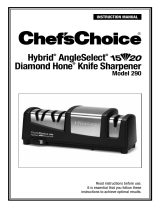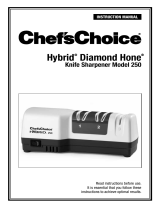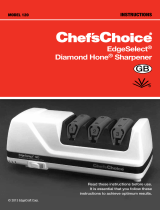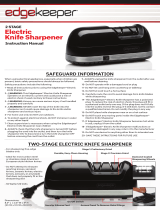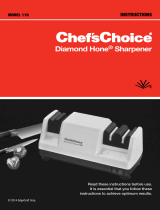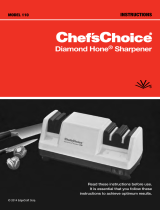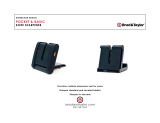Page is loading ...

MODEL 15
InstructIOns
Trizor XV
®
Knife Sharpener
EdgeSelect
®
—15° Edge Angle
Read these instructions before use.
It is essential that you follow these
instructions to achieve optimum results.
© 2015 EdgeCraft Corp.

2
IMPORTANT SAFEGUARDS
When using electrical appliances, basic safety precautions should always be
followed including the following:
1. Read all instructions. Every user should read this manual.
2. To protect against electrical hazards, do not immerse the Chef’sChoice
®
Trizor XV
®
Model 15 in water or other liquid.
3. Make sure that only clean knife blades are inserted in Trizor XV
®
Model 15.
4. Unplug from outlet when not in use, before putting on or taking off parts and before cleaning.
5. Avoid contacting moving parts.
6. Do not operate any appliance with a damaged cord or plug or after the appliance
malfunctions, or is dropped or damaged in any manner.
U.S. customers: You can return your sharpener to EdgeCraft’s factory for service where
the cost of repair or electrical or mechanical adjustment can be estimated. When the
electrical cord on this appliance is damaged, it must be replaced by the Chef’sChoice
®
distributor or other qualified service to avoid the danger of electrical shock.
Outside U.S.: Please return your sharpener to your local distributor where the cost of
repair or electrical or mechanical adjustment can be estimated. If the supply cord of this
appliance is damaged, it must be replaced by a repair facility appointed by the manufac-
turer because special tools are required. Please consult your Chef’sChoice
®
distributor.
7. CAUTION! This appliance may be fitted with a polarized power plug (one blade is
wider than the other). To reduce the risk of electric shock, this plug will fit in a polar-
ized outlet only one way. If the plug does not fit fully in the outlet, reverse the plug. If it
still does not fit, contact a qualified electrician. Do not modify the plug in anyway.
8. The use of attachments not recommended or sold by EdgeCraft Corporation may
cause fire, electric shock or injury.
9. The Chef’sChoice
®
Trizor XV
®
Model 15 is designed to sharpen American, European,
and Asian style knives. Do not attempt to sharpen scissors, ax blades or any blade
that does not fit freely in the slots.
10. Do not let the cord hang over edge of table or counter or touch hot surfaces.
11. When in the “ON” position (Red flash on switch is exposed when “ON”), the
Chef’sChoice
®
sharpener should always be on a stable countertop or table.
12. WARNING: KNIVES PROPERLY SHARPENED ON YOUR Trizor XV
®
Model 15 WILL
BE SHARPER THAN YOU EXPECT. TO AVOID INJURY, USE AND HANDLE THEM WITH
EXTREME CARE. DO NOT CUT TOWARD ANY PART OF YOUR FINGERS, HAND OR BODY.
DO NOT RUN FINGER ALONG EDGE. STORE IN A SAFE MANNER.
13. Do not use outdoors.
14. Close supervision is necessary when any appliance is used by or near children.
15. Do not use honing oils, water or any other lubricant with the Trizor XV
®
Model 15.
16. For household use only.
17.
SAVE THESE INSTRUCTIONS.

3
YOU MADE A GOOD CHOICE
The Trizor XV
®
Model 15 Sharpener from Chef’sChoice
®
is the world’s first sharpener
designed specially to create the exceedingly sharp and effective Trizor XV
®
, edge on all
household cutlery. Now you can enjoy knives that slice with astonishingly ease, yet have the
durability of the acclaimed Trizor
®
edge.
The Trizor XV
®
edge gives you the superior edge durability of the Chef’sChoice
®
triple
bevel Trizor
®
edge while forming each of the major edge facets at 15 degrees (30º total) for a
sharpness that matches the best of Asian knives. Asian artisans devoted lifetimes to develop
the skills required to hand sharpen edges of this quality. Now you can with the Trizor XV
®
Sharpener sharpen, hone and strop to the same perfection in a matter of seconds.
The Chef’sChoice
®
Model 15 is designed to place this superior 15 degree Trizor XV
®
edge on all
of your household knives whether they are European, American, Japanese, or other Asian styles.
Virtually all European and American style household knives are factory sharpened with edge
facets at 20 degrees. Most of the Asian knives, however are sharpened at 15º on each side of
the edge and that has established their reputation for edge sharpness.
UNDERSTANDING THE TRIZOR XV
®
EDGE
The original Trizor
®
edge, an innovation from Chef’sChoice
®
has long been acknowledged for its
superior sharpness and durability. Its uniqueness is the result of the triple bevel design of each
of the two edge facets that meet to form the edge.
The Trizor
®
design uses multiple diamond abrasives of successively finer grits to shape the
facets into a modified gothic arch to create an edge that has added strength, durability, and
sharpness. In the original Trizor
®
edge the major edge angle is created at 20 degrees.
The new Trizor XV
®
edge is likewise made by a three step sharpening, honing and
stropping process but the major edge angle is set at 15º (See Figure 1) for added sharpness
and effortless use.
You will appreciate the reduced effort in cutting and the enhanced sharpness. Remember the
edge will be sharper than you expect.
Figure 1. The Trizor
®
XV Edge is
sharper with the added durability of
the triple bevel edge.
The Trizor XV
®
Edge
Model 15 edge
Conventional 20° Edge
factory edge

4
GETTING ACQUAINTED WITH THE TRIZOR XV
®
SHARPENER – MODEL 15
The Model 15, Figure 2 is a three stage sharpener with 100% diamond abrasives in the first two
stages to sharpen and hone the edge, followed in Stage 3 with the Chef’sChoice
®
proprietary
stropping/polishing disks to create an astonishingly sharp edge. You will find it easy to convert
any of your household knives to the new Trizor XV
®
, 15 degree edge. It is very likely that all of
your conventional kitchen knives whether European or American brands have been sharpened
through the years at about 20 degrees. However, if you have any Asian design knives, they were
likely sharpened at 15 degrees at the factory; these can be restored to factory-new condition in
just minutes. All traditional-single beveled-Asian knives such as sashimi knives require special
care and must be sharpened primarily on one side of the edge. All other Asian blades are sharp-
ened by the same procedures as the European/American brand knives.
You will find you can also sharpen your serrated blades with the Model 15 by following the
special instructions included on page 12.
The Model 15 retains the popular EdgeSelect
®
feature, introduced by Chef’sChoice
®
, which al-
lows you to sharpen each knife according to your intended use, such as gourmet food prepara-
tion, butchering, dressing of game or of fish. The three stages can be used in
different sequences, for example to give you either an astonishingly sharp, smooth faceted edge
for effortless cutting or one with a selected amount of residual “bite” – ideal for cutting fibrous
food, meats, stalky vegetables or dressing of game. This feature is described in detail in a fol-
lowing section.
The Model 15 is equipped with a manually actuated diamond dressing system that can be used,
when necessary, to clean any accumulated food or sharpening debris from the
surface of the ultrafine abrasive Stage 3 polishing/stropping disks. We strongly urge that you
always thoroughly clean your knives before sharpening them. Unless you are a heavy user of
the sharpener, you will be able to sharpen for months or even a year or more before you need to
dress the stropping/polishing disks. Only if you sense a distinct decrease in polishing efficiency
in Stage 3 is there any need to use this convenient feature described on page 13.
Figure 2. The Model 15 Trizor XV knife sharpener. Figure 3. A typical kitchen knife.
Heel
Bolster
Handle
Edge
Tip

5
Because of their heavy duty and specialized blade designs we do not recommend the Model
15 for the very thick European cleavers or the heavy hunting knives with concave blade faces.
These can be readily sharpened in Models 120, 130, 2000, and 2100. The Model 15 is ideal for
sharpening Asian cleavers and fish fillet knives.
Never operate the sharpener from the back side. Use just enough downward pressure when
sharpening to ensure uniform and consistent contact of the blade edge with the
abrasive disks on each stroke. (See Suggestion 5, page 14). Additional pressure is unnecessary
and will not speed the sharpening process. Avoid excessive cutting into the plastic
enclosure. Accidental cutting into the enclosure however will not functionally impact operations
of the sharpener or damage the edge.
Try a practice pull through the sharpener before you turn on the power. Slip the knife blade
smoothly into the left slot between the left angle guide of Stage 1 and the plastic knife holding
spring. Do not twist the knife. Move the blade down in the slot until you feel it
contact the diamond disk. Pull it towards you lifting the handle slightly as you approach the tip.
This practice pull will give you a feel for the spring tension. Remove the knife and read the fol-
lowing instructions specific to the type of knife you will be sharpening.
HOW TO CREATE THE TRIZOR XV
®
EDGE ON
EURO/AMERICAN AND CONTEMPORARY ASIAN BLADES
If you have European or American brand knives, it is extremely easy to convert their edge to the
Trizor XV
®
(15 degree) edge. The procedure outlined here applies equally to sharpening contem-
porary Asian blades. The edge of Euro/American and contemporary Asian knives are identical
in that they are sharpened on both sides of the edge. If you have any uncertainty about the type
of Asian blades you wish to sharpen, refer to their description on pages 10 and 11. Virtually all
Asian blades are factory sharpened at 15 degrees.

6
To convert from the existing Euro/American edge to the Trizor XV
®
edge or to sharpen
contemporary Asian blades, start with the Sharpening Stage 1 as follows:
EURO/AMERICAN AND CONTEMPORARY ASIAN BLADES
START IN SHARPENING STAGE 1
Turn ON the power and pull the length of blade thru the left slot (Figure 4) and then thru the
right slot of Stage 1, using the left and right slots on alternate pulls. (Take about 3-4 seconds for
each pull of a 5” long blade). The first time you sharpen an European or American knife it may
take up to 20 pair of pulls to fully re-angle the edge of a thin blade. Thicker blades will require
more pulls. Check for a burr as described below and continue to make more pulls if necessary
to create a small burr along the entire length of the blade.
If you are sharpening a contemporary Asian blade (which probably has been sharpened
previously at 15 degrees) you will find that only a few (1-2) pairs of alternating pulls (alter-
nating left and right slots) will be needed to develop a burr. Do not over sharpen. When you have
developed a burr along the full blade length proceed to Stage 2.
DETECTING THE BURR
To confirm the presence of a burr (see Figure 5) move your forefinger carefully across the edge
in the direction shown. Do not move your finger along the edge – to avoid cutting your finger. If
the last pull was in the right slot, the burr will appear only on the right side of the blade as you
normally hold it and vice versa. The burr, when present, feels like a rough and bent extension
of the edge; the opposite side of the edge feels very smooth by comparison. If there is no burr
continue sharpening in Stage 1, alternating left and right slots until a full burr develops. When a
burr is present along the entire blade length proceed as below to Stage 2.
HONING IN STAGE 2
Make about 1 or 2 pairs of pulls through Stage 2 (Figure 6) alternating each pull in the left and
right slots. Take about 3 seconds for each pull on a 5 inch (12 cm) long blade.
Check for a burr before proceeding to Stage 3. If necessary make additional pairs of pulls to
develop a burr along the entire length of blade before proceeding to Stage 3.
Figure 4. Sharpen Euro/American and contemporary
Asian knives first in Stage 1.
Burr
Figure 5. When you create a distinct burr along the
blade edge, it can be detected by sliding finger across
and away from the edge. Caution! See text.

7
STROPPING/POLISHING THE EDGE IN STAGE 3
Pull the blade through the left slot of Stage 3 (see Figure 7) and then through the right slot of
Stage 3. Make 3 pairs of pulls, alternating each pull in the left and right slots. You should take
about 3 to 4 seconds for each pull for a 5 inch (12 cm) long blade.
Then make 2 pairs of alternating faster pulls in this Stage, about 1 second per pull for a 5 inch
(12 cm) blade to put a final polish on the edge.
Check the blade for sharpness. For a sharper edge make a few more pairs of fast pulls and
check for sharpness.
RE-SHARPENING EURO/AMERICAN AND CONTEMPORARY ASIAN BLADES
Re-sharpen following the Stropping/Polishing procedure in Stage 3 as described above.
Depending on its use, you should be able to re-sharpen to a razor sharp edge 3 or more times
using only Stage 3 before finding it necessary to again hone in Stage 2. Hone in Stage 2 only
when you find it is taking too long or too many pulls in Stage 3 to bring the edge to razor
sharpness. In that event, follow the honing and stropping/polishing sequence in Stages 2 and 3
as described above.
SHARPENING THE TRADITIONAL (SINGLE BEVEL)
JAPANESE BLADE
Traditional Japanese knives such as the sashimi blade shown here are single sided and have
a large factory bevel (see Bevel A, Figure 10c) on the front side of the blade. There are a large
number of manufacturers of knives of this type used widely to prepare sashimi. The factory
bevel (Bevel A) is commonly ground at about 10 degrees, but there are exceptions and that
angle is not standardized at the factories. Designs of the traditional Japanese knives and the
Figure 6. Honing in Stage 2 (left slot). Figure 7. Stropping/Polishing in Stage 3.

8
detailed structure of the cutting edges likewise vary widely from one manufacturer to the next,
however there are some similarities. The cutting edge consists of a small primary facet on the
front face of the blade below the large bevel and a much smaller secondary microfacet along the
back face. Commonly the back side microfacet (Figure 10d) can be easily seen only with a hand
magnifier. The back face is ground flat at the factory or more commonly it is slightly hollow
ground to ensure that an effective microfacet can be formed there as part of the cutting edge.
Because of the lack of standardization, the manual approach used to sharpen these knives in
Asia has proven difficult, laborious and time consuming. The Chef’sChoice
®
Model15 Sharpener
is designed to sharpen all traditional Asian blades and to create a factory-quality edge.
Before you start to sharpen a traditional blade, examine it carefully in order to confirm that you
have the traditional single bevel blade and to determine whether you have a right or left handed
type as described on page 10 and 11, Figure 10c. It is essential that you follow carefully the
sharpening procedure and sequence as described below in order to achieve the optimum edge
on your traditional blade.
Again confirm which side of the blade has the large factory Bevel A. Hold the blade in your hand
(as when you are cutting) and if the large factory bevel is on the right side of the blade, the blade
is right handed. For the right handed blades start sharpening in the left slot of Stage 2 so that
only the beveled side (right side) of the edge will contact the honing wheel.
STEP 1
START HONING TRADITIONAL JAPANESE KNIVES IN STAGE 2
(RIGHT HANDED BLADES)
In this example which assumes your traditional blade is right handed, you must hone only in the
left slot of Stage 2 (see Figure 8). The number of pulls that you need to make depends on the
factory angle of Bevel A (Figure 10c and 10d) and how dull your blade may be.
Make five (5) to ten (10) pulls in only the left slot of Stage 2 and then check for a burr along the
back side of the blade edge. (The burr created in Stage 2 will be small but easily felt as shown in
Figure 8. Honing a right-handed traditional Japanese
knife in Stage 2.
Figure 9. Stropping/Polishing a traditional Japanese
knife in Stage 3.

9
Figure 5. Make certain the burr is present along the entire length of the edge. If there is no burr
or only a partial burr, continue to make additional pulls all in the left slot about five (5) at a time
and check for a burr after each group of five (5) pulls. In general 20-30 total pulls in the left slot
will be adequate to raise a burr; it is unlikely to take more than 50 left slot pulls to create the
burr. When a burr is confirmed, proceed to Step 2.
STEP 2
STROPPING/POLISHING THE FINAL EDGE ON TRADITIONAL JAPANESE BLADE IN STAGE 3
(RIGHT HANDED BLADE)
a. Make five (5) regular pulls 3-4 seconds each only in the left slot of Stage 3 (Figure 9) and
then proceed to remove any burr as follows:
b. Make one (1) regular pull in right slot of Stage 3 along the back side of the edge.
c. Make several fast pulls (one [1] second each) in the left slot of Stage 3.
d. Make one (1) fast pull in the right slot of Stage 3.
Check the blade carefully for sharpness using a thin sheet of paper. The blade should be razor
sharp. If not razor sharp repeat 3c and 3d above and retest the blade for sharpness.
NOTE: If your traditional blade is excessively worn or if the edge is chipped and irregular you can
use the left slot of Stage 1 to recondition the edge. Use the left slot only (for right handed blades).
Make as many pulls as necessary to reestablish a smooth uniform edge line. Use a black felt pen
to mark facet and follow progress of sharpening along the edge until edge line is restored. Then
proceed in Stage 2 and 3 as described on page 8 and this same page above.
RESHARPENING THE TRADITIONAL JAPANESE BLADE (RIGHT HANDED)
In general you will be able to resharpen quickly by following the sequence a thru d of Step 2 in
the preceeding section. Repeat this if necessary to obtain a razor sharp edge. When resharpen-
ing only in Stage 3 fails to develop a sharp edge or if the edge has been substantially dulled you
will need to re-hone the edge in Stage 2. Use only the left slot of Stage 2. Generally you will find
that about five (5) re-honing pulls will be sufficient in Stage 2. In any event develop a burr before
moving back to Stage 3. Finish the edge in Stage 3 following Step 3a, b, c, d.
SHARPENING LEFT HANDED TRADITIONAL BLADES
The procedure you must use with left handed blades is similar to that procedure for right handed
blades as detailed above – Except, in all cases the slots you must use are reversed. Where the
sharpening procedure for right handed blades calls for use of just the left slot, you must use only
the right slot when sharpening a left-handed blade. Likewise use the left slot where the right
handed instructions call for using the right slot.

10
DESCRIPTION OF EURO/AMERICAN AND ASIAN BLADES
In general you will find that Euro/American blades shown in Figure 10a are sturdier than the
more delicate and thinner contemporary Asian blades. The variation among commercially
available knives of any type is great and in fact some Euro/American blades are very thin and
certain Asian knives have a thicker cross-section designed for heavier work.
1. EUROPEAN/AMERICAN BLADES
While most of the Euro/American knives (shown
on the right), Figure 10a have a thick cross-section
designed for heavier work, the range of blade thick-
ness in these familiar blades is great and certain of
these knives, such as the conventional paring, fillet
and utility blades, have a relatively thin cross-section
well suited to their intended application. Euro-pean/
American straight edge blades are universally double
beveled (sharpened on both sides of the blade.)
2. CONTEMPORARY ASIAN KNIVES
The more popular Asian blades; the thin, light weight
Santoku and Nakiri for example are generally double
faceted (sharpened on both faces of the blade) as
shown in Figure 10b. Occasionally Santoku knives
are sold with single facets (Figure 10c below) but
these are not readily available in the United States.
There are other but somewhat heavier double-fac-
eted Asian knives, the Deba and Gyutou, popular in
Asia, which are used for chopping hard vegetables,
for tailing and filleting fish and for meats. These are
basically Asian chefs knives designed for heavier duty
work. The Chinese cleaver is included in this class.
3. TRADITIONAL JAPANESE KNIVES
The traditional Japanese knife is single beveled and
has a wide factory bevel A along one face of the
blade above a small edge facet. These are sold as
either right handed or left handed
versions as shown in Figure 10c. The large wide
factory bevel A is ground, commonly at about 10
degrees. The most popular example of this type
blade is the sashimi knife also known as Yanagi and
Takohiki, designed as shown to the right. This lengthy,
slicing blade is ideal for preparing very thin slices
of raw tuna or salmon. The back side of this blade
is commonly slightly hollow ground. A small single
cutting edge facet of about 15º is created along the
Figure 10a. European/American blade.
Figure 10b. Double faceted contemporary Asian blades.
Figure 10c. Single beveled traditional Asian blades.

11
front of the edge of the sashimi blade as shown in
Figures 10c and 10d in order to establish the ge-
ometry of the cutting edge. An even smaller cutting
micro-facet (barely visible to the unaided eye) is
customarily created on the back face of the blade to
enhance the sharpness of the finished edge. Figure
10d shows a greatly enlarged cross-section view of
a typical factory edge on the traditional single-bevel
Japanese knife. The large factory bevel A serves
to deflect the food slice away from the blade as it
is cut. When sharpening the traditional Japanese
blades, always follow the instructions carefully. Also
remember these knives will be extremely sharp.
THE EDGESELECT
®
FEATURE –
OPTIMIZING THE KNIFE EDGE FOR EACH USE
The gourmet chef will appreciate the unique ability of the Model 15 to tailor the knife edge to
optimize performance for each individual cutting task. These procedures are not suggested for
your traditional Asian knives.
GOURMET FOOD PREPARATION:
(EUROPEAN, AMERICAN, AND CONTEMPORARY ASIAN KNIVES)
Where the finest and smoothest cuts are preferred in order to prepare smooth unmarked
sections of fruits or vegetables, sharpen in Stages 1 & 2 as described above and make extra
pulls thru Stage 3. Three or more pairs of fast pulls with each pull alternating in the left and
right slots of Stage 3 will refine the third facet and create remarkably smooth and sharp edges,
(Figure 11a) ideal for the gourmet chef.
Figure 10d. Cross-section of a typical factory traditional
Asian knife edge, magnified 50x (right-handed).
Figure 11a. A larger polished facet
adjacent to edge is ideal for
gourmet preparations.
Figure 11b. Retention of larger
microflutes adjacent to edge helps
when cutting fiberous foods.
Figure 11c. For fish and poultry
retention of finer microflutes
adjacent to edge can be helpful.

12
When resharpening the Gourmet edge use Stage 3 each time (alternating left and right slots). If
after a number of resharpenings, it is taking too long to resharpen, you can speed the process
by resharpening first in Stage 2 following the procedures detailed, and then resharpen in Stage
3. By this method you will retain very smooth edges and prolong the life of your knives. This
procedure unlike conventional sharpeners will give you extra-ordinary sharp knives every day
while removing very little metal.
FOR MEATS, FIELD DRESSING AND HIGHLY FIBROUS MATERIALS
For butchering, field dressing or cutting fibrous materials you may find it advantageous to sharp-
en in Stage 1 – followed directly by Stage 3. This will leave sharpened microflutes along the
facets near each side of the edge (Figure 11b) that will assist in the cutting of such materials.
To prepare this type edge on either your Euro/American knives or contemporary Asian knives,
sharpen in Stage 1 (see page 6) until a burr is developed along the edge. Then move directly to
Stage 3 and make two or three pairs of pulls there.
To preserve this type of edge, when the knife needs resharpening, use Stage 3 for only one or
two resharpenings. Then go back to Stage 1 for one pull in each of the left and right slots and
then return directly to Stage 3. Do not oversharpen in Stage 1.
FOR GAME AND FISH
The optimum edge for cooked poultry generally can be obtained by using Stage 2 followed by
Stage 3. (Figure11c). For raw poultry, Stage 1 followed by Stage 3 as described above may
be preferable.
For filleting fish use a thin but sturdy blade sharpened in Stages 2 and 3.
PROCEDURE FOR SHARPENING SERRATED BLADES
Serrated blades are similar to saw blades with scalloped depressions and a series of pointed
teeth. In normal use the pointed teeth do most of the cutting.
Figure 12. Use only Stage 3 for sharpening
serrated knives.
Figure 13. Use dressing tools sparingly (see following
page for instructions).

13
Serrated blades of all types can be sharpened in the Chef’sChoice
®
Model 15. However, use
only Stage 3 (Figure 12) which will sharpen the teeth of the serrations and develop microblades
along the edge of these teeth. Generally five (5) to ten (10) pairs of alternating pulls in Stage 3
will be adequate. If the knife is very dull more pulls will be needed. If the knife edge has been
severely damaged thru use make one fast pull (2-3 seconds for an 8” blade) in each of the right
and left slots of Stage 2, then make a series of pulls in Stage 3, alternating right and left slots.
Excessive use of Stage 2 will remove more metal along the edge then is necessary in order to
sharpen the teeth.
Because serrated blades are saw-like structures, the edges will never appear to be as “sharp”
as the edge on a straight edge knife. However, their tooth-like structure can be helpful—for ex-
ample to break the skin on hard crusty foods and penetrate other materials such as cardboard.
DRESSING OF STROPPING/POLISHING DISKS – STAGE 3
The Model 15 is equipped with a built-in system to manually clean/dress the stropping/polishing
disks in Stage 3. In the event these disks become glazed with grease, food or sharpening debris,
they can be cleaned and reshaped by actuating the manual lever on the rear of the sharpener.
This lever is located within a recess as shown in Figure 13 on the lower left corner as you face
the rear of the Sharpener. To actuate the cleaning/dressing tool, make sure the power is “ON”
and simply press the small lever in the recess to the right, hold about 3-4 seconds and then
press to the left and repeat for 3-4 seconds. When the lever is moved in one direction, the dress-
ing tool cleans and reshapes the active surface of one stropping/polishing disk. By moving the
lever in the opposite direction you clean the other disk.
Use this clean/dress mechanism only if the Stage 3 white disks are seriously darkened and
when Stage 3 no longer appears to be stropping/polishing well. Using this tool removes material
from the surface of the Stage 3 disks and hence, if used excessively, it will unnecessarily remove
too much of the abrasive surface – wearing the disks out prematurely. If that should occur,
factory replacement of the disks will become necessary. If you clean your knives regularly before
sharpening you may need to clean or dress the Stage 3 disks less than once a year.

14
SUGGESTIONS
1. Always clean all food, fat and foreign materials from the blade surfaces before sharpening
or resharpening. If badly soiled, use detergent and water to clean.
2. Some contemporary Asian knives and Granton type blades are dimpled and some contem-
porary and traditional Asian blades are made of layered Damascus steel. All of these should
be sharpened accordingly to these instructions depending solely on whether the knife style
is contemporary (two facets) or a traditional single facet Asian blade.
3. Always pull the blades at the recommended speed and at a constant rate over length of
blade. Never interrupt or stop the motion of the blade when in contact with abrasive disks.
4. Carefully follow the detailed procedures for each type blade for best results and to extend
the useful life of your knives. The sharpening sequence is especially important with the
single sided traditional Asian blades.
5. The edge of the knife blade, while sharpening, should remain in contact with the abrasive
disks as the knife is withdrawn from the guiding slot. To sharpen the blade near the tip of a
curved blade, lift the handle up slightly as you approach the tip of the blade but just enough
so that the edge as it is being sharpened maintains audible contact with the honing or
stropping disk.
Figure 14. If your blade has a significant choil it may
be helpful to place our finger behind it as shown
when sharpening.
Figure 15. Place your index finger as shown behind the
choil as the knife is inserted into the sharpening slot
(see Suggestion 8.)
Figure 16. Removing cover under base to clean out
metal dust. (See Normal Maintenance section)

15
6. To increase your proficiency with the Chef’sChoice
®
Model 15, learn how to detect a burr
along the edge (as described on page 6). While you might be able to sharpen well without
using this technique, it is the best and fastest way to determine when you have sharpened
sufficiently in the preliminary steps. This will help you avoid oversharpening and ensure
incredibly sharp edges every time. Cutting a tomato or a piece of paper is a convenient
method of checking for finished blade sharpness.
7. Use only light downward pressure when sharpening – just enough to establish secure
contact with the abrasive disk.
8. If your knife has a significant choil you may find it helpful to place your index finger within
or just behind the choil (see Figures 14 and 15) as you insert the blade in the sharpener.
Your finger can act as a “stop” and prevent you from inserting the blade so far that the
choil area will catch on the front stop-bar of the sharpener as you withdraw the blade. A
little practice will help you perfect this technique. As you insert the blade let your finger
slide down the front of the sharpener.
9. Used correctly, you will find you can sharpen the entire blade to within 1/8” of the bolster
or the sharpener handle. This is a major advantage of the Chef’sChoice
®
Model 15 com-
pared to other sharpening methods—especially important when sharpening chef’s knives
where you need to sharpen the entire blade length in order to maintain the curvature of the
edge line. If your chef’s knives have a heavy, thick bolster near the handle extending to the
edge, a commercial grinder can modify or remove the lower portion of the bolster so it will
not interfere with the sharpening action, allowing you to sharpen the entire blade length.
10. The stropping/polishing disks in the Stage 3 are designed to last for years of use,however
you can maximize their useful life by periodically modifying your sharpening pattern in
Stage 2. The burr developed in Stage 2 will mildly wear the stropping/polishing disk it first
contacts in Stage 3. Vary your last pull in Stage 2 by sometimes making the last pull on the
left disk and at other times finish on the right disk of Stage 2.
11. Do not attempt to use this sharpener to sharpen either ceramic knives or scissors.

16
Assembled in the U.S.A. www.chefschoice.com
This product may be covered by one or more EdgeCraft patents and/or patents pending as marked on
the product. Chef’sChoice
®
, EdgeCraft
®
, Diamond Hone
®
, TrizorXV
®
, EdgeSelect
®
and the overall design
of this product are registered trademarks of the EdgeCraft Corporation.
Conforms to UL Std. 982 Certified to CAN/CSA Std. C22.2 No. 64
Certified to EN 60335-1, EN 60335-2, EN 55014-1+A1, EN 61000-3-2, EN 61000-3-3
© EdgeCraft Corporation 2015 Printed in China.
F15 C128207
®
EdgeCraft Corporation
825 Southwood Road, Avondale, PA 19311 U.S.A.
Customer Service 610-268-0500
NORMAL MAINTENANCE
NO lubrication is required for any moving parts, motor, bearings or sharpening surfaces. There
is no need for water on abrasives. The exterior of the sharpener may be cleaned by carefully
wiping with a soft damp cloth. Do not use detergents or abrasives.
Once a year or so as needed you should remove metal dust that will accumulate inside the
sharpener from repeated sharpenings. Remove the small rectangular clean-out cover (Figure
16) that covers an opening on the underside of the sharpener. You will find metal particles
adhered to a magnet attached to the inside of that cover. Simply rub off or brush off accumulated
filings from the magnet with a paper towel or tooth brush and reinsert the cover in the opening.
If larger amounts of metal or other dust have been created you can shake out any remaining
dust through the bottom opening when the cover is removed. After cleaning, replace the cover
securely with its magnet in place.
SERVICE
In the event post-warranty service is needed, return your sharpener to the EdgeCraft factory
where the cost of repair can be estimated before the repair is undertaken. Outside the USA,
contact your retailer or national distributor.
Please include your return address, daytime telephone number and a brief description of the
problem or damage on a separate sheet inside the box. Retain a shipping receipt as evidence of
shipment and as your protection against loss in shipment.
/

